Abstract
Background:
The occurrence of periodontal diseases in humans has been a global problem. Certain risk factors affect the initiation, progression, and severity of periodontitis. The present study has been designed to assess the periodontal status in relation to risk factors such as age, gender, oral hygiene practices, and smoking among the young adults of the Sebha city in Libya.
Materials and Methods:
A cross-sectional study was carried out among 1,255 subjects aged between 18 years and 34 years. 1,006 (80.15%) subjects were females and 249 (19.84%) subjects were males. Data was generated by conducting interview and clinical examination. The periodontal status was assessed by using Community Periodontal Index of Community Periodontal Index of Treatment Needs. The Chi-square test and analysis of variance were used for statistical analysis at 5% level of significance.
Results:
A total of 89.08% reported the use of toothbrush and toothpaste for cleaning and 10.91% used other aids, such as finger and Siwak. Of the 1,255 subjects, 3.98% were current smokers (all males). Only 4.7% had healthy periodontium (CPI code 1), while majority of 44.30% were detected with calculus (CPI code 2). Nearly 40.63% had shallow pockets (CPI code 3), 6.29% had bleeding (CPI code 1), and 4.06% had deep pockets (CPI code 4). The overall mean CPI score was 2.33 (0.84). Age and gender showed a statistically significant difference with the CPI codes.
Conclusion:
The result of this study provides baseline information for planning a preventive program. With preventive procedures being implemented at this young age, there is a possibility that the prevalence of periodontal disease will be lesser during adulthood.
Keywords: CPITN index, epidemiological surveys, oral hygiene practices, periodontal disease, periodontal status
INTRODUCTION
The occurrence of periodontal disease in human is a global problem.[1] Age, gender, oral hygiene practices, and smoking are among the important risk factors that can affect the initiation, progression, and severity of periodontitis. The prevalence and severity of periodontal disease is found to increase with age.[2,3,4] Periodontal disease is found to affect the male sex more than female sex.[5,6,7] Furthermore, lack of oral hygiene encourages plaque formation, which leads to increase in pathogenic bacteria that are associated with severe forms of periodontal disease.[8] Since time immemorial, tooth brushing has been considered ideal for maintaining a good oral hygiene. Despite the relationship between tooth brushing and periodontal disease being unclear; the breakthrough came in with Rajala et al.[9] reporting the disease to be more prevalent in sporadic toothbrush users than otherwise. Additionally, a positive association between tooth brushing and low periodontal disease prevalence has been confirmed in some studies.[9,10,11] Smoking has been recognized as a primary behavioral risk factor for periodontal disease.[5,6,12,13,14,15,16] Studies suggest that the smokers are 11 times more likely than non-smokers to harbor the bacteria that cause periodontal disease and are 4 times more likely to have advanced periodontitis.[17,18]
The Sebha city is situated in South-Western Libya with a population of about 1,30,000 and people come from various urban areas surrounding it; therefore, it has a heterogeneous society with a low level of health education.[19] As per Leous[20] periodontal disease is one of the main problems in Libya; Bleeding, dental calculus and shallow pockets is prevalent in almost all the young adults. It is also worth while to note that some of the 18-year-old male never clean their teeth with a toothbrush.
The periodontal disease data from several countries collected by using CPITN, is stored in the WHO Global Oral Health Data Bank.[21] The Sebha city belongs to the countries of the Regional office for Eastern Mediterranean (EMRO). The oral health data for EMRO countries is available for the ages; 15 years, 17 years, 15-19 years, 16-20 years, 35-44 years, and 65-44 years. Usually, epidemiological studies are primarily concentrated on adolescents, adults, and elderly population. Unfortunately, no information is available for the young adults (18-34 years). The plausible reason for this lack of information comes from the fact that early studies presented results which suggested little or no periodontal destruction before the age of 30 years.[22]
Taking into consideration the lack of data about periodontal disease among young adults, the present study has been designed to assess the periodontal status among the young adults of Sebha city. The study also assesses the relationship of the risk factors, such as age, gender, oral hygiene practices, and smoking with periodontal disease.
MATERIALS AND METHODS
A cross-sectional survey was conducted among the young adults aged 18-34 years from Sebha city, Libya. The city was divided into four zones, and one representative area from each zone was selected. Al-Jadeed, Al-Mahdia, Gurda, and Sukkara were the four selected areas. A pilot study was conducted on 30 volunteers from Al-Jadeed. This was carried out to obtain the prevalence of the periodontal disease so as to calculate the sample size for the main study. The pilot study results revealed that the prevalence of periodontal disease was 56% in Al-Jadeed. The sample size was determined by using the formula n = z2 pq/d2. Assuming that the values obtained are z = a point on normal distribution with 95% confidence, p = prevalence of periodontal disease from pilot study, q = 100-p, d = admissible error that is 10% of prevalence.
![]()
Out of 314 people each were selected from the four representative areas. Therefore, the total study sample had 1256 people. The survey was conducted at the Primary Health Center (PHC) in the selected areas. The medical officer posted at the PHC was responsible for enrolling the participants for the study in the respective areas. Young adults who visited the PHC for the 1st time and voluntarily wished to participate were recruited for the survey. Those with orthodontic appliance and who were undergoing dental treatment were excluded. Schedules were prepared such that the examination of the participant took place on one particular day of the week for one PHC center. At first, the participant was interviewed to collect information as per the pro-forma [Appendix 1] and later underwent a clinical examination. The oral examination was conducted by a single, trained, and calibrated examiner who was assisted by a recording clerk. The examiner used a CPITN-C probe and mouth mirror. During calibration, 10% of the sample was re-examined and a kappa value of 0.8 was obtained. This value indicates a good intra-examiner consistency. CPI of the CPITN was used to record the periodontal status.[23] American Dental Association ADA type 3 examination procedure was followed.[24] The codes and criteria of the index were as per the WHO, Oral Health Survey.[24] Three indicators of periodontal status; gingival bleeding, calculus, and pockets were assessed. The mouth was divided into six sextants. For participants above 20 years, 10 index teeth were examined, which were (16, 17), 11, (26, 27), (36, 37), 31, and (46, 47). When two index teeth were considered in a sextant, the tooth with the highest score was recorded. For those below 20 years, only 6 index teeth were examined, which were 16, 11, 26, 36, 31, and 46. The overall CPI score of the participant represented the value of the highest recorded code for that individual. During examination, the probe was kept parallel to the long axis of the tooth, the tip was inserted gently into the gingival sulcus or pocket, and the total extent of sulcus or pocket was explored. The codes were:[24]
Code 0: Teeth are healthy
Code 1: Bleeding observed, directly or by using a mouth mirror, after probing
Code 2: Calculus detected during probing, all the black band on the probe is visible
Code 3: Pocket is 4-5 mm (gingival margin within the black band on the probe)
Code 4: Pocket is 6 mm or more (black band on the probe not visible)
X: Sextant is excluded (less than 2 teeth present)
9: Not recorded.
All the subjects were well-educated and signed the informed consent form. The ethical board, scientific committee of the Faculty of dentistry, Sebha University, Sebha, Libya approved the protocol of the study.
Statistical analysis was carried out with the help of a Statistical Package for Social Sciences (SPSS version 16). The mean, standard deviation, and percentages were calculated. Chi-square test and analysis of variance (ANOVA) was used to compare between the groups at 5% level of significance. The variables were age, gender, frequency of tooth brushing, and smoking habit that were compared with the CPI codes.
RESULTS
Out of the determined sample size of 1,256 people, the study population comprised of 1,255 individuals, of which 1,006 (80.15%) were females and 249 (19.84%) were males. The distribution of the sample as per the age and age groups is shown in Table 1.
Table 1.
Distribution of the study sample according to the age
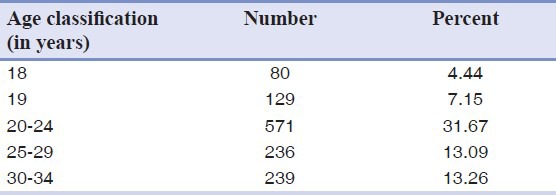
Regarding the oral hygiene practices, overall, 1,118 (89.08%) people reported to have used toothbrush and toothpaste for cleaning and 137 (10.91%) people used other aids, such as finger and Siwak. Only 50 (3.98%) people were current smokers and all were males, of which maximum (n = 22) people smoked 10-20 cigarettes/day.
Overall, the CPI analysis showed that a majority of 44.30% (n = 556) were detected with calculus (CPI code 2) followed by 40.63% (n = 510) with shallow pockets (CPI code 3), 6.29% (n = 79) with bleeding (CPI code 1), and 4.06% (n = 51) with deep pockets (CPI code 4). Only 4.7% (n = 59) had healthy periodontium (CPI code 0).
Table 2 shows the distribution of people according to the CPI codes in relation to the different variables considered in the study. Age and gender showed significant statistical difference. The frequency of tooth brushing and smoking were not significantly related to the CPI codes.
Table 2.
Distribution of people according to the Community periodontal index CPI codes in relation to the different variables
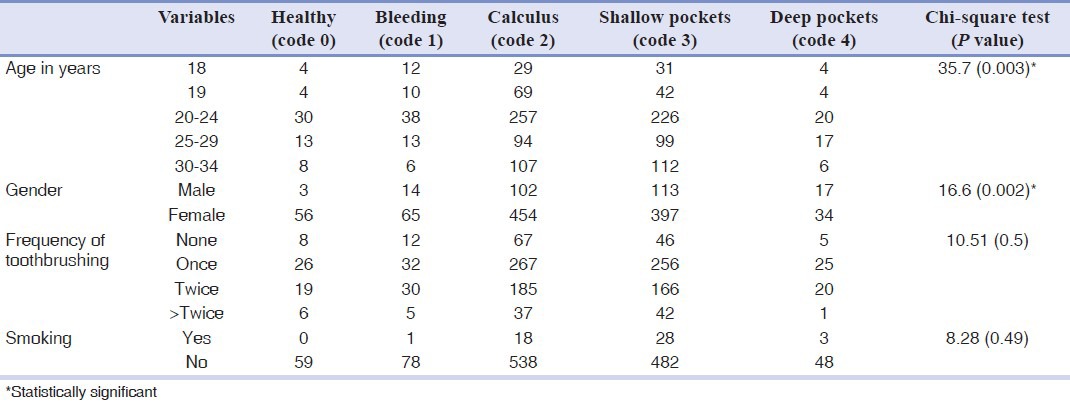
The overall mean CPI score was 2.33 (0.84). Figure 1 shows the mean CPI scores in different ages and age groups. It was observed that as age advances, the CPI score also increases.
Figure 1.
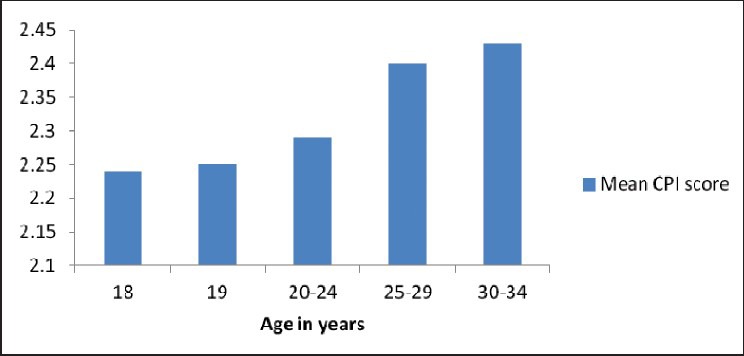
Mean CPI score of the sample for different ages
Table 3 shows the mean (SD) number of sextants as per the CPI codes in relation to age. A maximum of 2.45 sextants were healthy among 18 years old, which further gradually decreased as the age advanced. From 19 years onward, maximum sextants were detected with calculus. Maximum sextants with shallow pockets were noted among 25 years and above. Overall, the mean sextants with deep pockets were the least. The ANOVA test showed a significant relation of mean sextant scores and age.
Table 3.
Mean (SD) number of sextants as per the CPI codes in relation to age

DISCUSSION
The literature search for information regarding the oral health status of the population in Sebha resulted in the presence of only one PubMed indexed article by Hassan[19] and one document that was an assignment report on the oral health situation in Socialist People's Libiyan Arab Jamahiriya submitted to WHO Geneva by Leous.[20]
The study by Hassan[19] among patients attending the dental clinic in Sebha, Libyan Arab Jamahiriya, reported that the people here, have poor oral hygiene and low level of education. Furthermore, it was found that caries (54%) and periodontal disease (41%) were the main causes for the high frequency of tooth extraction.
The report by Leous[20] was a pathfinder study conducted on 849 children and 269 adults from 14 sites of the following localities: Tripoli, Sebha, Benghazi, Zwara, Ajelat, and Kaddah. The CPITN index was used to assess the periodontal disease, and its results indicate that the periodontal disease was present from a very young age. Very small population in the age group of 20-24 years was found to have a healthy periodontium. While drawing a comparison between the population aged 18 years and 20-24 years, respective percentage distributions were observed: 3% and 2% had healthy periodontium, 8% and 0% had bleeding, 66% and 69% had calculus, 25% and 27% had shallow pockets, and 0% and 2% had deep pockets. Comparing results of the present study with the results reported by Leous[20] indicate the percentages of people with CPI code 0, 1, 3, and 4 to be different, while the prevalence of calculus (Code 2) was found to be the highest in both the studies.
In the WHO Global oral health data bank for periodontal disease[21] using CPITN index, there was no data available for comparison in the age group 18-34 years from EMRO countries. However, for the ages 18 and 19 years, data from countries[21] belonging to Regional office for Europe (EURO), Regional office for Western Pacific (WPRO), Regional office for Africa (AFRO), and Regional office for South East Asia (SEARO) was available and was compared with the present study participants of the same age [Figure 2]. Figure 2 presents a view for all the countries, calculus (code 2) was the highest-recorded CPI score except in South Africa where the percentage of healthy periodontium was the highest (51%). Overall, it was observed that the highest prevalence of shallow pockets (34%) was from Sebha.
Figure 2.
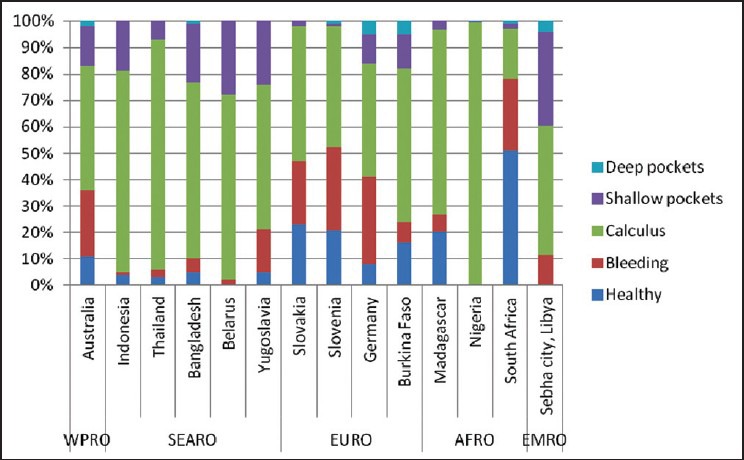
Overview of periodontal status from different countries
It is widely assumed that symptoms of periodontal diseases escalate with age.[4] Table 3 clearly indicates that the mean number of sextants for lower codes of 0 (healthy) and 1 (bleeding) was highest among 18 years old, but as the age increased, the mean number of sextants for higher codes of 2 (calculus) and 3 (shallow pockets) increased. The presence of shallow pockets, which is an indication of the deterioration of periodontium, was more prevalent in the age group of 25 and above.
In the present study, a significant relation was obtained between CPI codes and gender [Table 2]. Although, there was an unequal distribution of males and females, the individual percentage calculation showed that more females had healthy periodontium, bleeding, and calculus as compared to males. However, the prevalence of shallow and deep pocket was more prevalent in the males. Studies[12,24,25,26] indicate that predominantly males, because of their smoking habit, have shown more susceptibility to periodontal diseases. Though, the smokers in the present study were all males, significant difference in periodontal status was not observed with smoking. This observation is in line with the other studies.[27,28,29]
A total of 89.08% of the study population practiced tooth brushing with toothpaste. This is a good percentage when compared to other previous studies on Libyan[30] and Sudanese[31] population, where the percentages were 74.6% and 53%, respectively. The remaining 10.91% of the Sebha population were using finger or Miswak. Currently, many of the world populations in India, Pakistan, several African countries, the Arab countries, and most of the Muslim world still use Miswak.[32] The study reported that the Sudanese regular Miswak users had better oral health and lower levels of oral pathogens than adult Sudanese who used a modern toothbrush regularly.[32] However, in the present study, the frequency of tooth brushing was not significantly associated with the CPI codes.
CONCLUSION
Within the limits of the study, it can be concluded that only 4.7% young adults in Sebha have healthy periodontium. The benefits accuring from the control of periodontal diseases and promoting good periodontal health include, improved quality of life, enhanced general well-being and appearance, reduced halitosis, elimination of bleeding gums, reduced potential threat to longevity of teeth, and improved masticatory function. More importantly, ensuring implementation of preventive procedures amongst young adults could possibly lessen the prevalence of periodontal diseases during their adulthood.
This study is probably, the first of its kind to report data on the young adults in Sebha and this information can be utilized for planning a preventive model that will include dental health education and preventive procedures.
ACKNOWLEDGMENTS
The authors wish to thank the Medilinkers Research consultancy for providing help in statistical analysis and editing the manuscript.
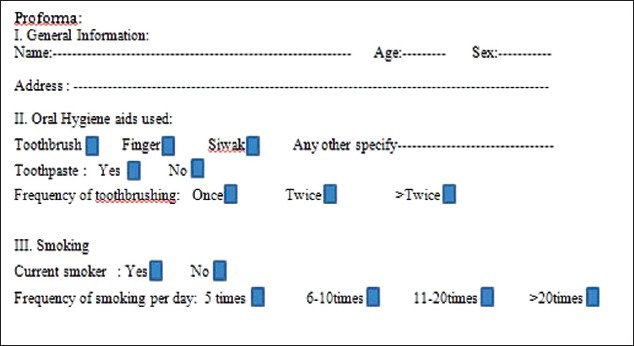
Footnotes
Source of Support: Nil
Conflict of Interest: None declared.
REFERENCES
- 1.Albandar JM, Rams TE. Global epidemiology of periodontal diseases: An overview. Periodontol 2000. 2002;29:7–10. doi: 10.1034/j.1600-0757.2002.290101.x. [DOI] [PubMed] [Google Scholar]
- 2.Perry DA, Newman MG. Occurrence of periodontitis in an urban adolescent population. J Periodontol. 1990;61:185–8. doi: 10.1902/jop.1990.61.3.185. [DOI] [PubMed] [Google Scholar]
- 3.Oliver RC, Brown LJ, Löe H. Periodontal diseases in the United States population. J Periodontol. 1998;69:269–78. doi: 10.1902/jop.1998.69.2.269. [DOI] [PubMed] [Google Scholar]
- 4.Bagińska J, Wilczyńska-Borawska M, Stokowska W. The evaluation of CPITN index among adults living in Podlasie region. Adv Med Sci. 2006;51:119–21. [PubMed] [Google Scholar]
- 5.Hyman JJ, Reid BC. Epidemiologic risk factors for periodontal attachment loss among adults in the United States. J Clin Periodontol. 2003;30:230–7. doi: 10.1034/j.1600-051x.2003.00157.x. [DOI] [PubMed] [Google Scholar]
- 6.Kocher T, Schwahn C, Gesch D, Bernhardt O, John U, Meisel P, et al. Risk determinants of periodontal disease – An analysis of the Study of Health in Pomerania (SHIP 0) J Clin Periodontol. 2005;32:59–67. doi: 10.1111/j.1600-051X.2004.00629.x. [DOI] [PubMed] [Google Scholar]
- 7.Bouchard P, Boutouyrie P, Mattout C, Bourgeois D. Risk assessment for severe clinical attachment loss in an adult population. J Periodontol. 2006;77:479–89. doi: 10.1902/jop.2006.050128. [DOI] [PubMed] [Google Scholar]
- 8.Al-Shammari KF, Al-Khabbaz AK, Al-Ansari JM, Neiva R, Wang HL. Risk indicators for tooth loss due to periodontal disease. J Periodontol. 2005;76:1910–8. doi: 10.1902/jop.2005.76.11.1910. [DOI] [PubMed] [Google Scholar]
- 9.Rajala M, Selkäinaho K, Paunio I. Relationship between reported toothbrushing and dental caries in adults. Community Dent Oral Epidemiol. 1980;8:128–31. doi: 10.1111/j.1600-0528.1980.tb01272.x. [DOI] [PubMed] [Google Scholar]
- 10.Löe H. Oral hygiene in the prevention of caries and periodontal disease. Int Dent J. 2000;50:129–39. doi: 10.1111/j.1875-595x.2000.tb00553.x. [DOI] [PubMed] [Google Scholar]
- 11.Davies RM, Davies GM, Ellwood RP. Prevention. Part 4: Toothbrushing: What advice should be given to patients? Br Dent J. 2003;195:135–41. doi: 10.1038/sj.bdj.4810396. [DOI] [PubMed] [Google Scholar]
- 12.Johnson GK, Guthmiller JM. The impact of cigarette smoking on periodontal disease and treatment. Periodontol 2000. 2007;44:178–94. doi: 10.1111/j.1600-0757.2007.00212.x. [DOI] [PubMed] [Google Scholar]
- 13.Tomar SL, Asma S. Smoking-attributable periodontitis in the United States: Findings from NHANES III. National Health and Nutrition Examination Survey. J Periodontol. 2000;71:743–51. doi: 10.1902/jop.2000.71.5.743. [DOI] [PubMed] [Google Scholar]
- 14.Amarasena N, Ekanayaka AN, Herath L, Miyazaki H. Tobacco use and oral hygiene as risk indicators for periodontitis. Community Dent Oral Epidemiol. 2002;30:115–23. doi: 10.1034/j.1600-0528.2002.300205.x. [DOI] [PubMed] [Google Scholar]
- 15.Petersen PE, Bourgeois D, Ogawa H, Estupinan-Day S, Ndiaye C. The global burden of oral diseases and risks to oral health. Bull World Health Organ. 2005;83:661–9. [PMC free article] [PubMed] [Google Scholar]
- 16.Corraini P, Baelum V, Pannuti CM, Pustiglioni AN, Romito GA, Pustiglioni FE. Risk indicators for increased probing depth in an isolated population in Brazil. J Periodontol. 2008;79:1726–34. doi: 10.1902/jop.2008.070586. [DOI] [PubMed] [Google Scholar]
- 17.Axelsson P, Paulander J, Lindhe J. Relationship between smoking and dental status in 35−, 50−, 65−, and 75-year-old individuals. J Clin Periodontol. 1998;25:297–305. doi: 10.1111/j.1600-051x.1998.tb02444.x. [DOI] [PubMed] [Google Scholar]
- 18.Bergström J, Eliasson S, Dock J. Exposure to tobacco smoking and periodontal health. J Clin Periodontol. 2000;27:61–8. doi: 10.1034/j.1600-051x.2000.027001061.x. [DOI] [PubMed] [Google Scholar]
- 19.Hassan AK. Reasons for tooth extraction among patients in Sebha, Libyan Arab Jamahiriya: A pilot study. East Mediterr Health J. 2000;6:176–8. [PubMed] [Google Scholar]
- 20.Leous PA. Assignment report. Oral health situation, Socialist People's Libyan Arab Jamahiriya, 1982-83. [Last accessed 2012 Apr 30]. Available from: http://www.whqlibdoc.who.int/emro/-993/DENT_44_HMD_469.pdf .
- 21.The WHO Global Oral Health Data Bank for periodontal disease. [Last accessed 2012 Apr 30]. Available from: http://www.dent.niigata-u.ac.jp/prevent/perio/perio.xls .
- 22.Anerud Klaus E. Periodontal disease among young adults (1983) SoDM Masters thesis. Paper 11. [Last accessed on 2012 Apr 30]. Available from: http://www.digitalcommons.uconn.edu/sodm_masters/11 .
- 23.Baelum V, Scheutz F. Periodontal diseases in Africa. Periodontol 2000. 2002;29:79–103. doi: 10.1034/j.1600-0757.2002.290105.x. [DOI] [PubMed] [Google Scholar]
- 24.World Health Organization. Oral Health Surveys, Basic Methods. 4th ed. Geneva: World Health Organization; 1997. Assessment Form; pp. 21–37. [Google Scholar]
- 25.Joseph PA, Cherry RT. Periodontal treatment needs in patients attending dental college hospital, Trivandrum. J Indian Soc Periodontol. 1996;20:67–71. [Google Scholar]
- 26.Thomson WM, Poulton R, Broadbent JM, Moffitt TE, Caspi A, Beck JD, et al. Cannabis smoking and periodontal disease among young adults. JAMA. 2008;299:525–31. doi: 10.1001/jama.299.5.525. [DOI] [PMC free article] [PubMed] [Google Scholar]
- 27.Rao S, Homagain S, Singh BP. Periodontal status & treatment needs of an adult rural community. J Pierre Fauchard Acad. 1993;7:72–8. [PubMed] [Google Scholar]
- 28.Albandar JM, Streckfus CF, Adesanya MR, Winn DM. Cigar, pipe, and cigarette smoking as risk factors for periodontal disease and tooth loss. J Periodontol. 2000;71:1874–81. doi: 10.1902/jop.2000.71.12.1874. [DOI] [PubMed] [Google Scholar]
- 29.Al-Kayed A, Sawair FA, Burgan SZ, Khraisat A. Health hazards of tobacco smoking: An alarming lack of public awareness. The Saudi Dental Journal. 2005;17:63–8. [Google Scholar]
- 30.Fadilla YI, Sutan R. Proportion and factors related to periodontal disease among young adult attended Al-fatah dental faculty, Libya. Malaysian Journal of Public Health Medicine. 2011;11:40–3. [Google Scholar]
- 31.Khalifa N, Allen PF, Abu-bakr NH, Abdel-Rahman ME, Abdelghafar KO. A survey of oral health in a Sudanese population. BMC Oral Health. 2012;12:5. doi: 10.1186/1472-6831-12-5. [DOI] [PMC free article] [PubMed] [Google Scholar]
- 32.Darout IA, Skaug N. Comparative oral health status of an adult Sudanese population using miswak or toothbrush regularly. The Saudi Dental Journal. 2004;16:29–38. [Google Scholar]


